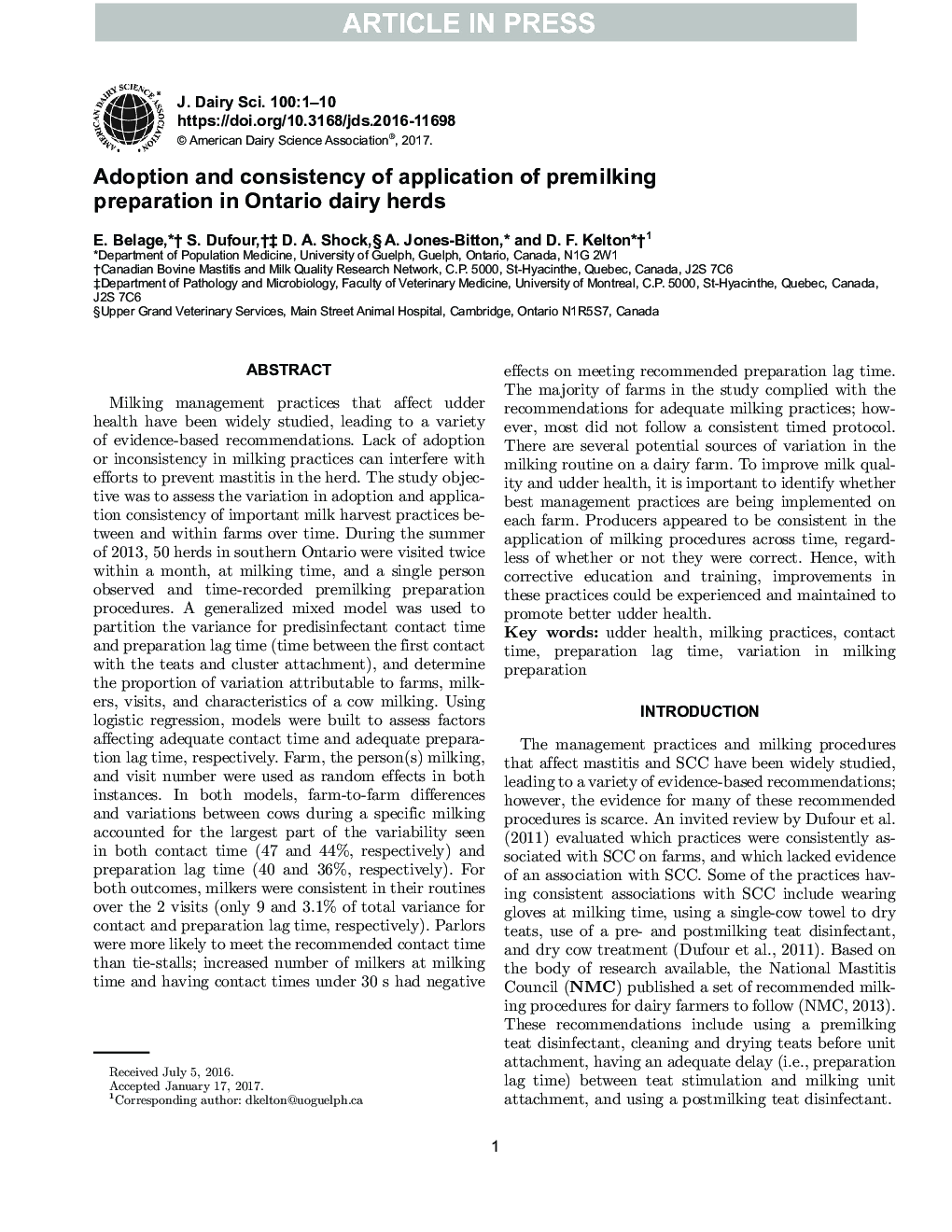| کد مقاله | کد نشریه | سال انتشار | مقاله انگلیسی | نسخه تمام متن |
|---|---|---|---|---|
| 5542185 | 1402515 | 2017 | 10 صفحه PDF | دانلود رایگان |
عنوان انگلیسی مقاله ISI
Adoption and consistency of application of premilking preparation in Ontario dairy herds
دانلود مقاله + سفارش ترجمه
دانلود مقاله ISI انگلیسی
رایگان برای ایرانیان
موضوعات مرتبط
علوم زیستی و بیوفناوری
علوم کشاورزی و بیولوژیک
علوم دامی و جانورشناسی
پیش نمایش صفحه اول مقاله

چکیده انگلیسی
Milking management practices that affect udder health have been widely studied, leading to a variety of evidence-based recommendations. Lack of adoption or inconsistency in milking practices can interfere with efforts to prevent mastitis in the herd. The study objective was to assess the variation in adoption and application consistency of important milk harvest practices between and within farms over time. During the summer of 2013, 50 herds in southern Ontario were visited twice within a month, at milking time, and a single person observed and time-recorded premilking preparation procedures. A generalized mixed model was used to partition the variance for predisinfectant contact time and preparation lag time (time between the first contact with the teats and cluster attachment), and determine the proportion of variation attributable to farms, milkers, visits, and characteristics of a cow milking. Using logistic regression, models were built to assess factors affecting adequate contact time and adequate preparation lag time, respectively. Farm, the person(s) milking, and visit number were used as random effects in both instances. In both models, farm-to-farm differences and variations between cows during a specific milking accounted for the largest part of the variability seen in both contact time (47 and 44%, respectively) and preparation lag time (40 and 36%, respectively). For both outcomes, milkers were consistent in their routines over the 2 visits (only 9 and 3.1% of total variance for contact and preparation lag time, respectively). Parlors were more likely to meet the recommended contact time than tie-stalls; increased number of milkers at milking time and having contact times under 30 s had negative effects on meeting recommended preparation lag time. The majority of farms in the study complied with the recommendations for adequate milking practices; however, most did not follow a consistent timed protocol. There are several potential sources of variation in the milking routine on a dairy farm. To improve milk quality and udder health, it is important to identify whether best management practices are being implemented on each farm. Producers appeared to be consistent in the application of milking procedures across time, regardless of whether or not they were correct. Hence, with corrective education and training, improvements in these practices could be experienced and maintained to promote better udder health.
ناشر
Database: Elsevier - ScienceDirect (ساینس دایرکت)
Journal: Journal of Dairy Science - Volume 100, Issue 5, May 2017, Pages 3902-3911
Journal: Journal of Dairy Science - Volume 100, Issue 5, May 2017, Pages 3902-3911
نویسندگان
E. Belage, S. Dufour, D.A. Shock, A. Jones-Bitton, D.F. Kelton,